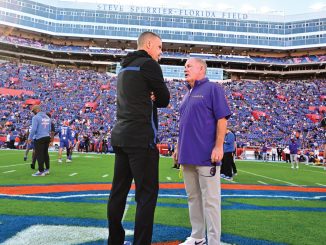
By TODD HORNE, EXECUTIVE EDITOR
Wins in the SEC rarely come gift-wrapped, and Saturday’s 23-22 decision over Arkansas was no exception—a gritty, grind-it-out affair that left the Tigers bowl-eligible but with more questions than catharsis.
For a defense that had endured a month of mounting frustrations, the performance was a welcome tonic: a unit that bent under pressure but held firm, limiting one of the nation’s most explosive offenses to field goals and turnovers. Yet as LSU savors the relief of snapping its skid, the game serves as a stark reminder of the season’s underlying dysfunction—one largely attributable to Brian Kelly’s inflexible approach at the helm. His midseason dismissal, following a string of disappointing results, underscores a scheme that demanded more mobility from the quarterback position than Garrett Nussmeier could provide, leaving the offense exposed and the defense overburdened.
Kelly’s tenure, which began with promise in 2022, unraveled amid mounting mismatches. He installed a spread offense built around read-options and the constant threat of a scrambling signal-caller—a system that thrived during Jayden Daniels’ Heisman year but clashed with Nussmeier’s pocket-passer profile. The fifth-year senior, a strong-armed but lead-footed operator and second-year starter, spent the fall as a frequent target behind an offensive line plagued by inconsistencies and injuries, allowing pressure on a league-high percentage of drop-backs. Saturday marked Nussmeier’s return to the sideline after a reinjury, paving the way for sophomore transfer Michael Van Buren to make his first start under center. After a slow start, Van Buren’s poise was evident: 221 passing yards, a go-ahead touchdown strike to Bauer Sharp, and a 35-yard rushing scramble that LSU needed badly and Van Buren delivered. It was the kind of dual-threat efficiency Kelly’s blueprint craved but rarely elicited from his starter. The Razorbacks, winless in the SEC entering the game but boasting one of the country’s most explosive attacks—averaging over 34 points per contest and ranking tied for fourth nationally in yards per play at 7.1—tested LSU from the outset. Their third-down conversion rate, near the top of the FBS at 48.7%, has made them a conversion clinic all season. The Tigers’ defenders, however, set the tone early. They surrendered four plays of 20 yards or more but excelled in critical moments, holding the Hogs to 2-of-11 on third downs and stuffing two goal-line attempts—one a plunge, the other a short-yardage gamble. Harold Perkins, the senior linebacker who has historically elevated his play against Arkansas, intercepted a jumped route to ignite the Tigers. Mansoor Delane, the veteran transfer in the defensive backfield, added a crucial pick in the end zone just before halftime. Three turnovers forced in total, coupled with those clutch stands, kept a high-scoring opponent in check.
Interim coach Frank Wilson, stepping in after Kelly’s October exit, praised the resilience afterward:
“Three turnovers, clutch stops, goal-line stands. That’s the reality of a heavyweight fight—you’re going to get hit, you’ve got to respond. Today, our guys did.” The sentiment rang true, particularly after a second-half sequence where Arkansas marched inside the 10-yard line only to be repelled, resulting in a wide-right field-goal miss. From there, running backs Harlem Berry and Caden Durham took over, combining for 175 all-purpose yards and a touchdown on 29 touches to run out the clock.
Offensively, the Tigers mirrored their season-long inconsistency—promising bursts amid prolonged struggles. Trailing by six in the fourth quarter with 92 yards to traverse, offensive coordinator Alex Atkins dialed up creativity uncharacteristic of Kelly’s regime: a trick snap to Ju’Juan Johnson, a Z-motion play to Zavion Thomas, and a double-reverse that sprung Johnson for a 14-yard connection to Trey’Dez Green. It was a welcome departure from the read-option heavy sets that often stalled drives, exposing Nussmeier to unblocked rushers. Special teams faltered at times—a blocked punt returned for a touchdown and errant kicks going out of bounds, —but the defense’s resolve covered the gaps.
The Arkansas victory, while vital, can’t erase the scars of earlier defeats, such as the 49-25 home loss to Texas A&M on October 25. There, the Aggies erupted for 35 second-half points after trailing at halftime, capitalizing on an LSU offense limited to 223 total yards (168 passing, 55 rushing) amid seven sacks. Kelly’s insistence on a scheme needing quarterback runs in a system ill-suited to Nussmeier’s skill set amplified the vulnerabilities, forcing the defense—a group that has held opponents to 19.3 points per game—to shoulder an outsized load.
With bowl eligibility secured, LSU turns to a home date with Western Kentucky before closing in Norman against Oklahoma, who likely will have everything to play for on that day.
Saturday’s effort affirmed the defense’s reliability: good enough to compete in the SEC, capable of carrying the team through lean offensive stretches. But it also highlighted the opportunity cost of Kelly’s unyielding vision—one that prioritized schematic purity over personnel fit, turning potential into frustration.
Under Wilson and Atkins, there’s room for adjustment: quicker rhythms to protect the passer, plays that leverage Van Buren’s mobility without overreliance. The path forward demands it. In a league that punishes rigidity, adaptation isn’t optional—it’s survival. For LSU, this win buys time. The real test is turning grit into growth.




Be the first to comment